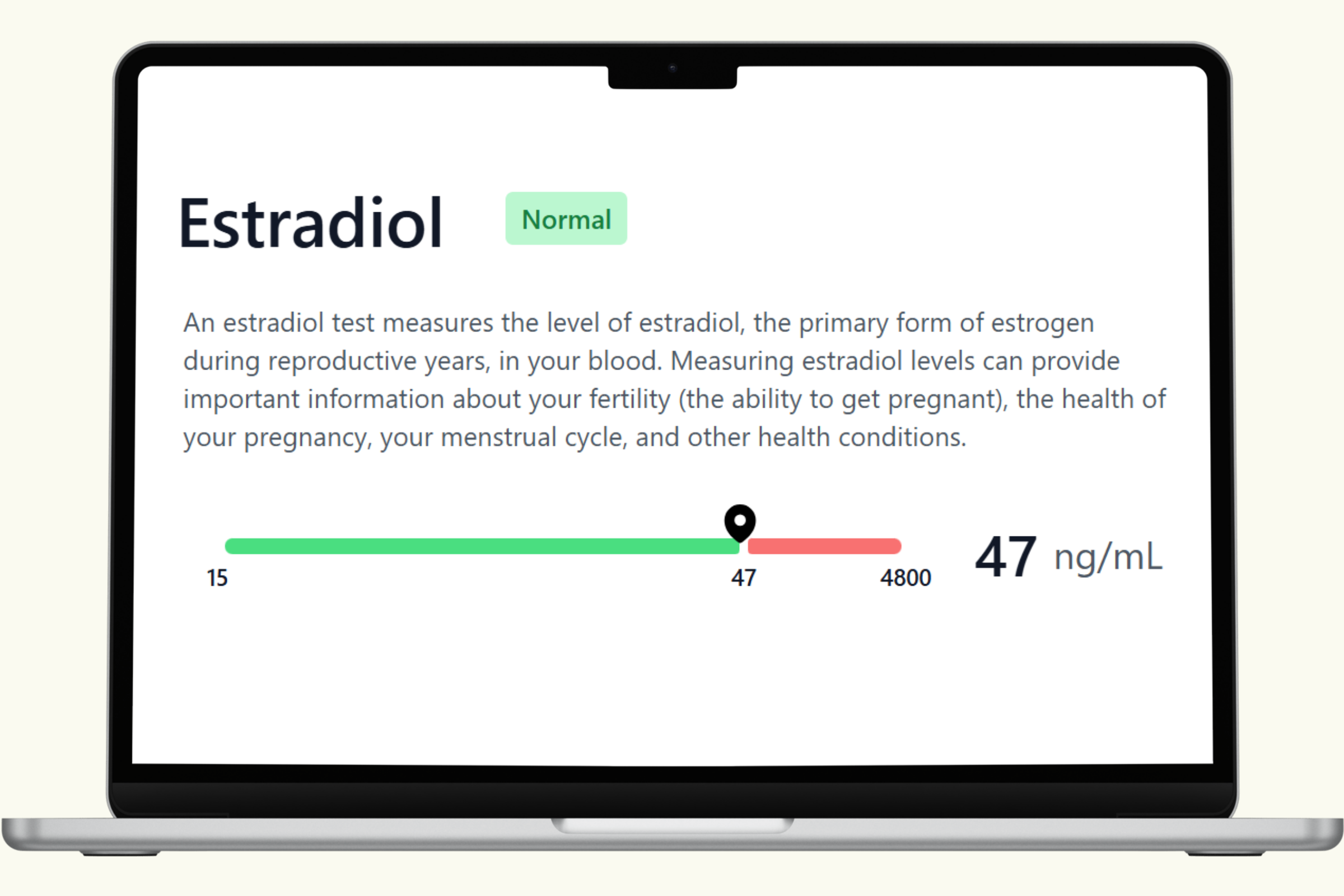Estradiol (E2) Blood Test: Understanding Your Estrogen Health
The Estradiol (E2) Blood Test, part of the PlexusDx Women’s Hormone Blood Test, measures levels of estradiol, the most active and important form of estrogen. While estrogen is a family of hormones, estradiol (E2) is the dominant form during the reproductive years, responsible for regulating menstrual cycles, fertility, and many aspects of overall health. Testing estradiol provides insight into reproductive status, hormone balance, and underlying causes of symptoms such as irregular cycles, infertility, or menopausal changes.
What is Estradiol (E2)?
Estradiol is produced mainly by the ovaries, with smaller amounts made by the brain, fat tissue, bones, and immune cells. As the primary estrogen in women of reproductive age, it influences a wide range of systems throughout the body, far beyond reproductive health. In the blood, most estradiol binds to proteins such as sex hormone-binding globulin (SHBG) and albumin. Only about 1% circulates freely and is biologically active. Since free estradiol is difficult to measure, most laboratory tests assess total (bound) estradiol levels.
Why Test Estradiol?
Estradiol levels provide valuable information in many areas of women’s health:
- Fertility and Ovulation: Estradiol rises before ovulation and helps prepare the uterine lining for implantation, making it a key marker for fertility evaluations.
- Menstrual Irregularities: Low or high estradiol may contribute to missed periods, heavy bleeding, or irregular cycles.
- Menopause and Perimenopause: As ovarian function declines, estradiol levels drop, leading to hot flashes, mood swings, and bone loss. Testing helps assess hormone status during this transition.
- Bone Health: Estradiol is crucial for bone density, and low levels increase the risk of osteoporosis.
- Hormone Therapy Monitoring: Estradiol levels are often checked to evaluate effectiveness of hormone replacement therapy or fertility treatments.
- Thyroid and Brain Function: Estradiol interacts with thyroid hormones and supports cognitive health, mood stability, and memory.
Estradiol Reference Ranges
Estradiol levels fluctuate throughout the menstrual cycle, during pregnancy, and across the lifespan. Below are commonly used reference ranges (pg/mL):
- Follicular Phase: 19 – 140 pg/mL
- Mid-cycle Peak (Ovulation): 110 – 410 pg/mL
- Luteal Phase: 19 – 160 pg/mL
- Postmenopause: < 35 pg/mL
- First Trimester Pregnancy: 188 – 2,497 pg/mL
- Second Trimester: 1,278 – 7,192 pg/mL
- Third Trimester: 6,138 – 37,560 pg/mL
Functional Ranges for Estradiol
Functional medicine practitioners often use narrower “optimal” ranges for estradiol, especially in the luteal phase:
- Follicular Phase (Optimal): 30 – 100 pg/mL
- Ovulation (Optimal): 150 – 300 pg/mL
- Luteal Phase (Optimal): 70 – 150 pg/mL
Values above or below these ranges may signal estrogen dominance, estrogen deficiency, or imbalances with progesterone and other hormones.
Symptoms of Low or High Estradiol
- Low Estradiol: Hot flashes, night sweats, vaginal dryness, low libido, irregular or absent periods, mood swings, memory problems, bone loss, and fatigue.
- High Estradiol: Weight gain, breast tenderness, bloating, heavy or prolonged periods, anxiety, and symptoms of estrogen dominance (especially if progesterone is low).
How the PlexusDx Estradiol Blood Test Works
The PlexusDx Women’s Hormone Blood Test uses a simple at-home collection method with an ADX dried blood spot card. This allows you to test estradiol without visiting a lab:
- Perform a quick finger prick to collect a small sample of blood.
- Apply the drops to the ADX collection card.
- Mail your sample back using the included pre-paid envelope.
Certified laboratories process your sample, and results are delivered quickly, giving you reliable insights into your hormone health from the comfort of home.
How to Interpret Estradiol Results
Your estradiol results should always be interpreted in context—cycle phase, age, pregnancy status, and symptoms all influence meaning. For example, low estradiol during the follicular phase may indicate ovarian dysfunction, while elevated estradiol outside of ovulation may suggest polycystic ovary syndrome (PCOS), ovarian cysts, or estrogen dominance. Postmenopausal women with elevated estradiol may require further evaluation for hormone therapy or other conditions.
Ways to Support Healthy Estradiol Balance
- Balanced Nutrition: Adequate protein, omega-3 fatty acids, and fiber support hormone metabolism.
- Liver Support: Since estradiol is metabolized in the liver, reducing alcohol, increasing cruciferous vegetables, and maintaining liver health is beneficial.
- Exercise: Regular physical activity helps regulate estrogen metabolism and supports healthy body weight.
- Stress Management: Chronic stress may disrupt the hypothalamic-pituitary-ovarian axis, impacting estrogen balance.
- Medical Care: Hormone therapy, supplements, or lifestyle strategies may be recommended by your provider depending on your results.
Key Takeaways
- The Estradiol (E2) Blood Test measures the most active form of estrogen, a hormone vital for reproductive, bone, brain, and thyroid health.
- Estradiol levels vary widely depending on cycle phase, pregnancy, or menopause.
- Both low and high estradiol can contribute to symptoms like irregular cycles, fertility challenges, hot flashes, weight gain, or bone loss.
- The PlexusDx Women’s Hormone Blood Test uses at-home dried blood spot collection for simple, accurate results.
- Understanding your estradiol levels helps guide decisions on fertility, menopause management, and overall hormonal health.
By testing estradiol with PlexusDx, you gain valuable insight into your hormone balance and take an important step toward managing your reproductive and long-term health with confidence.

Share:
Progesterone Blood Test
Luteinizing Hormone (LH) Blood Test